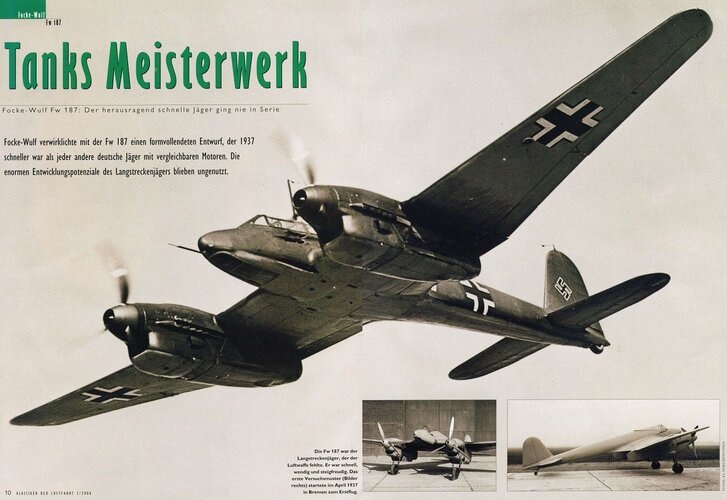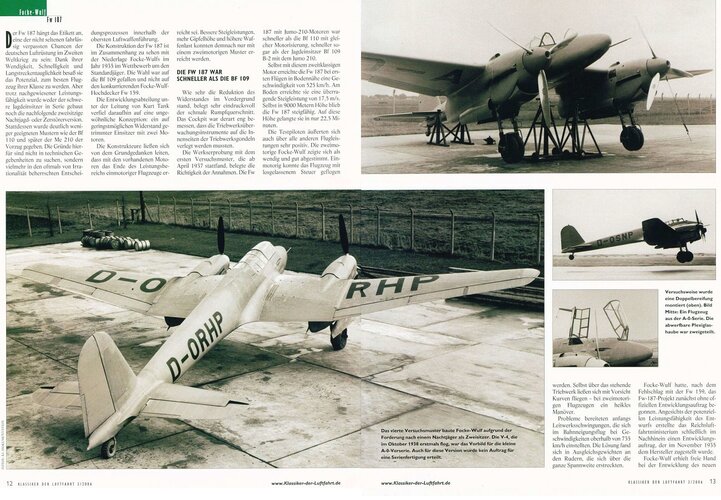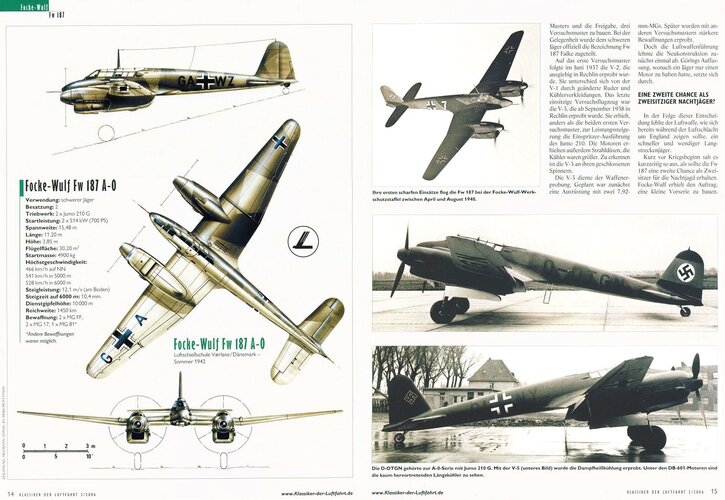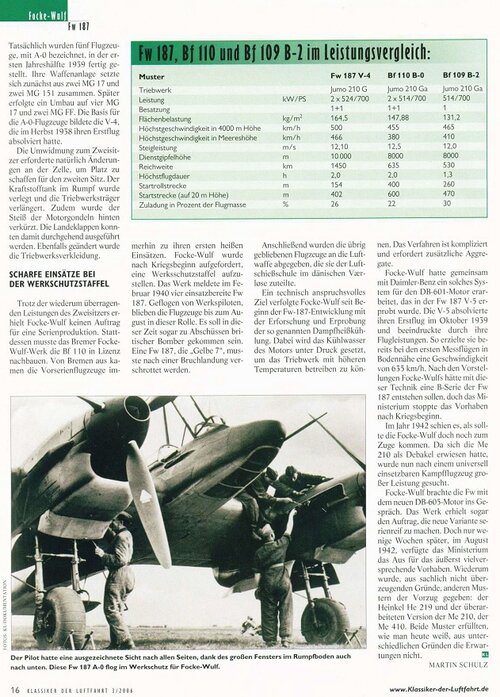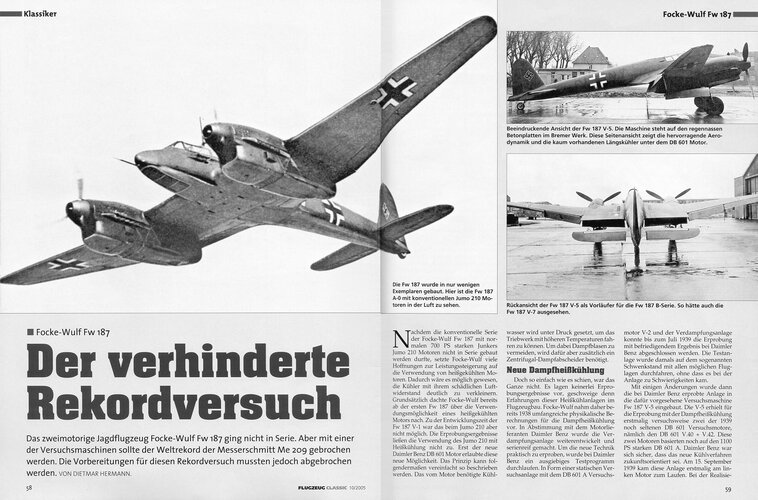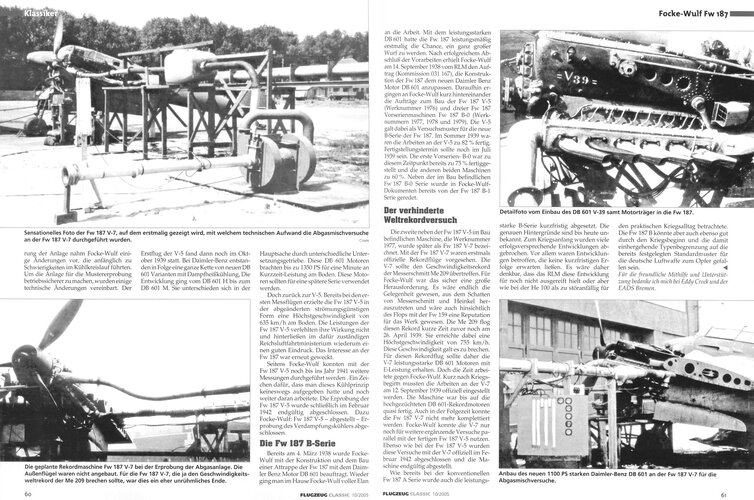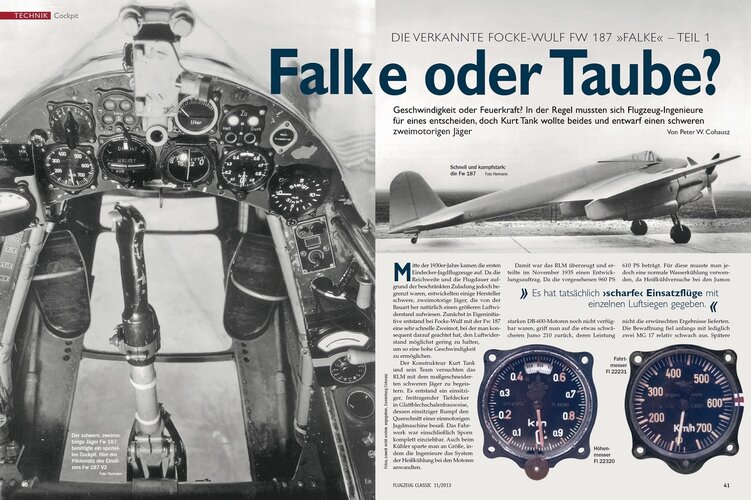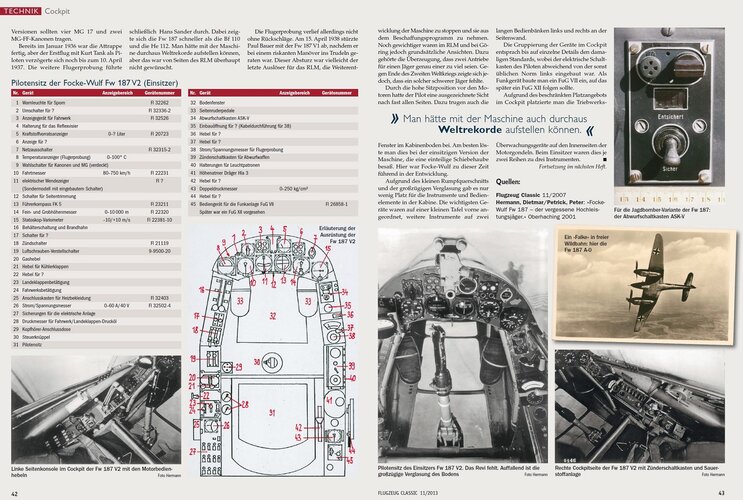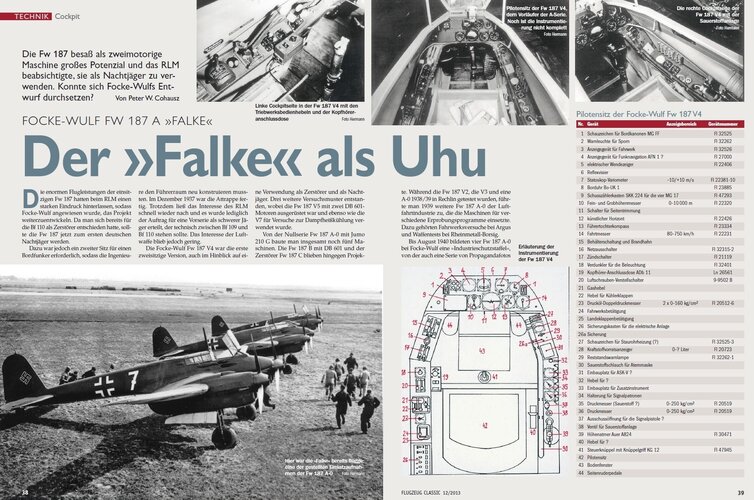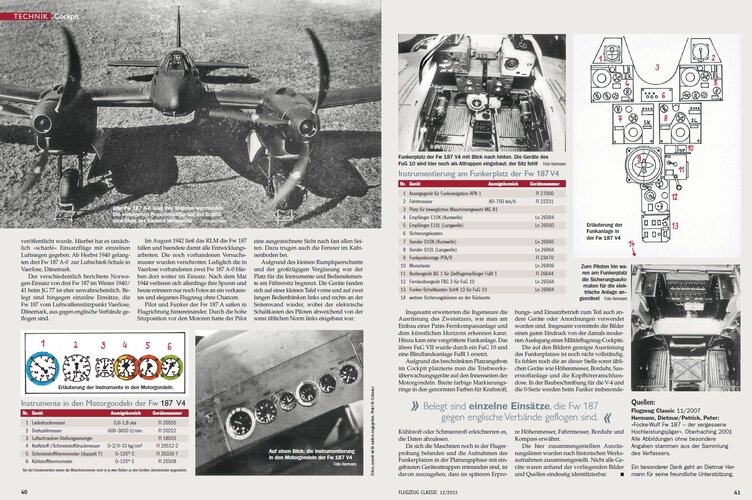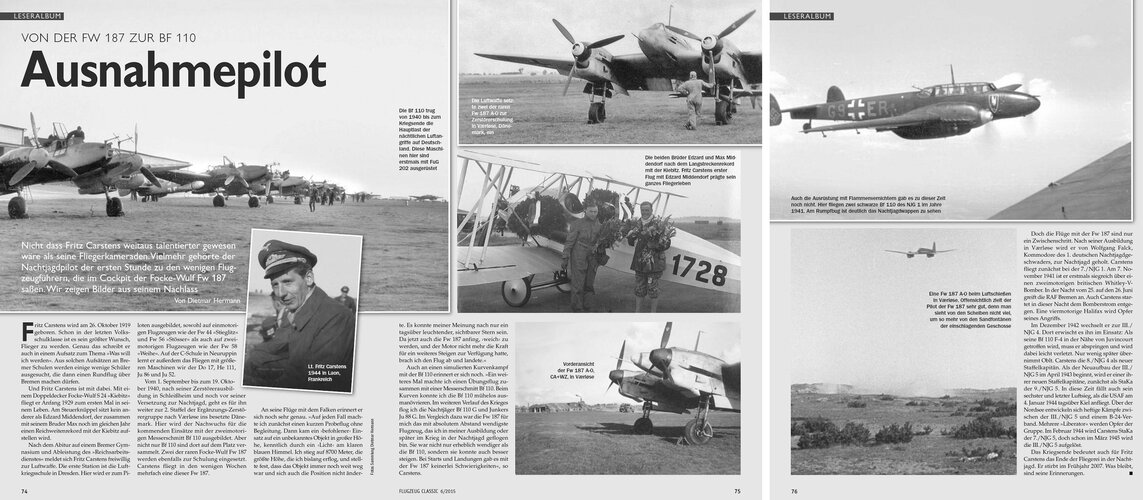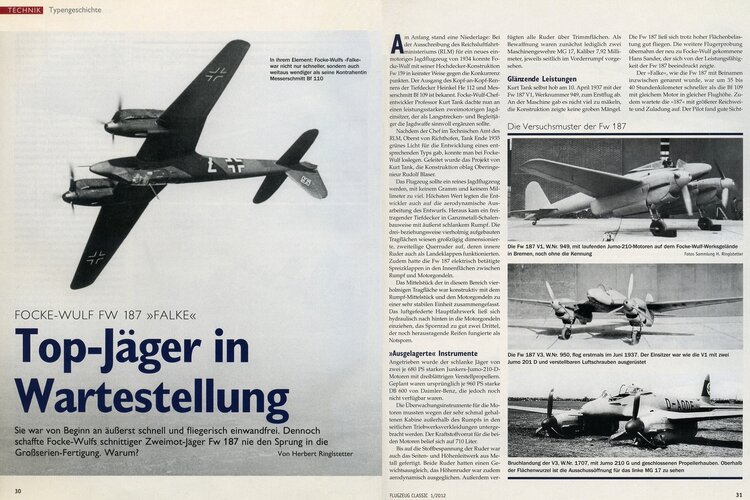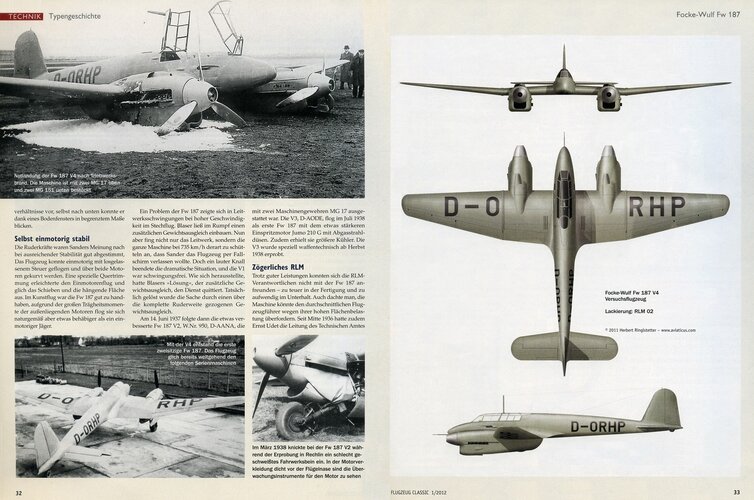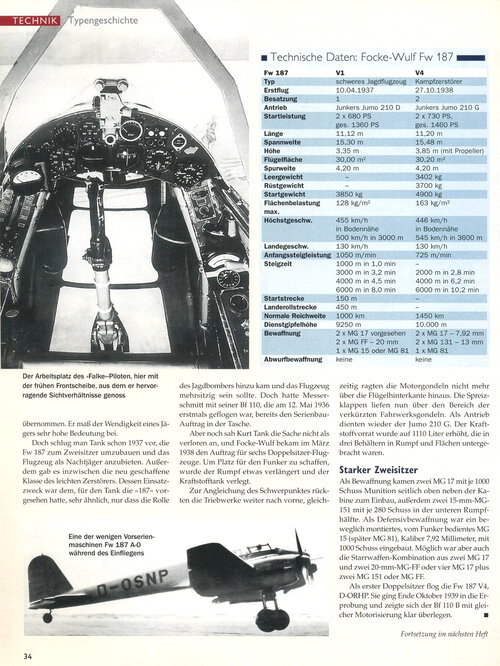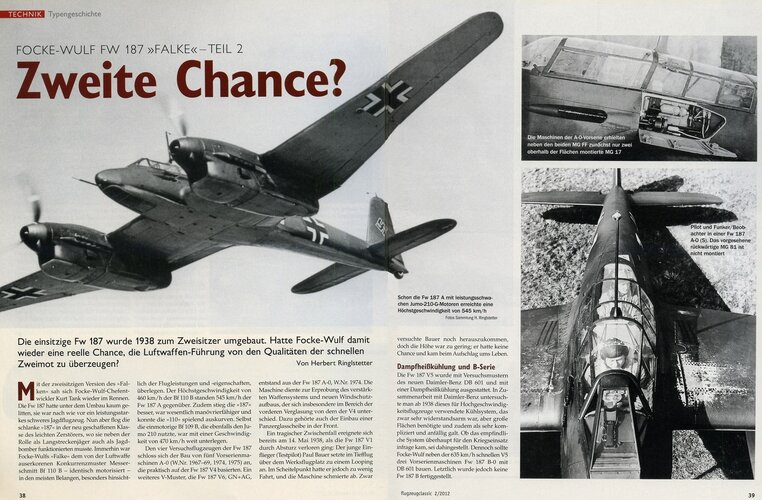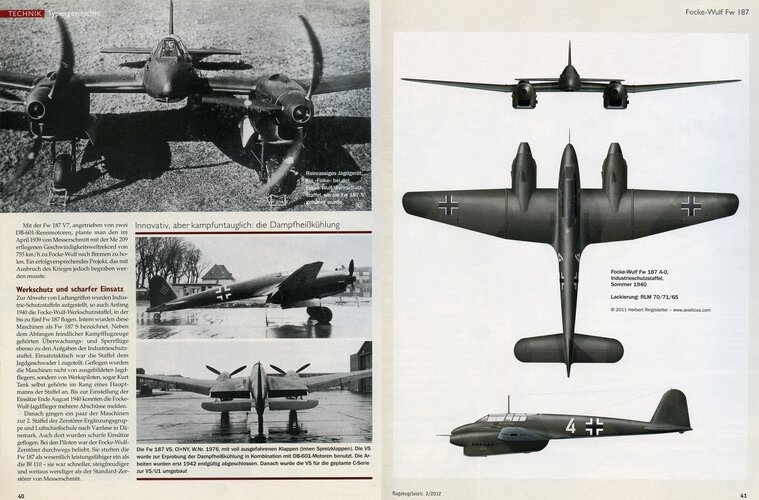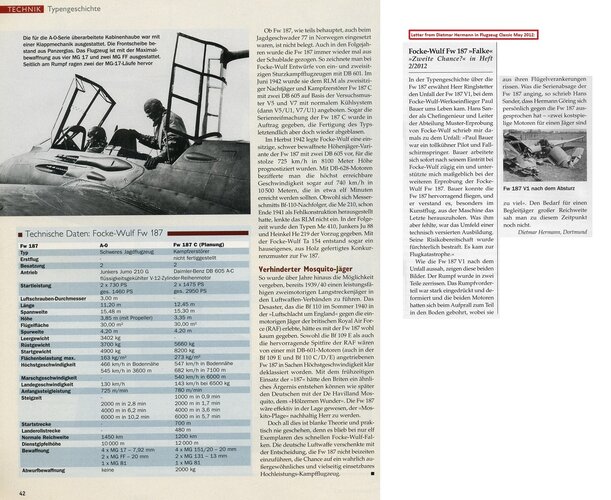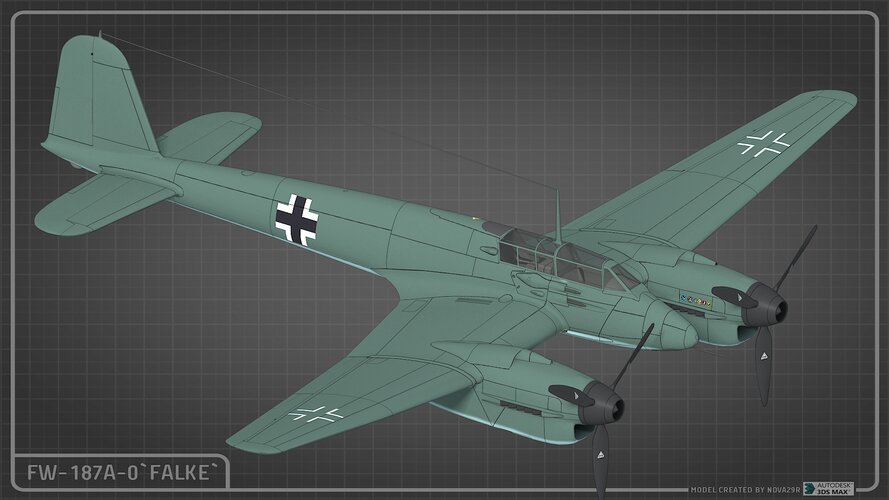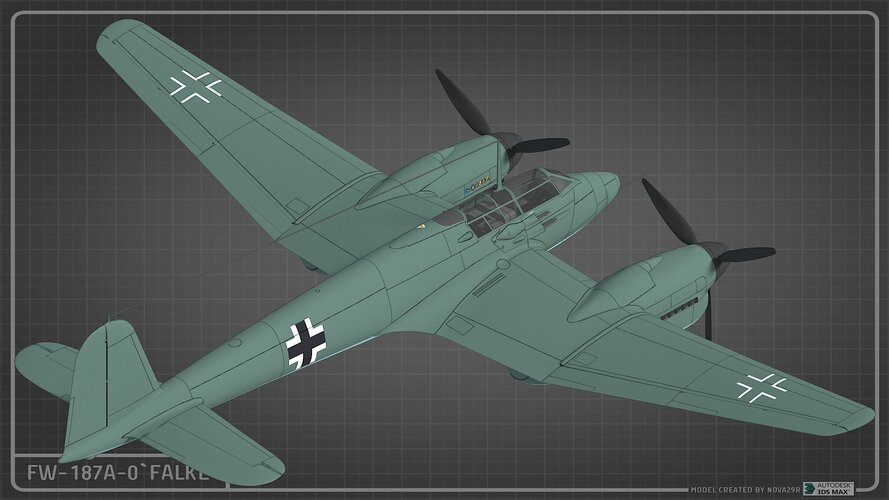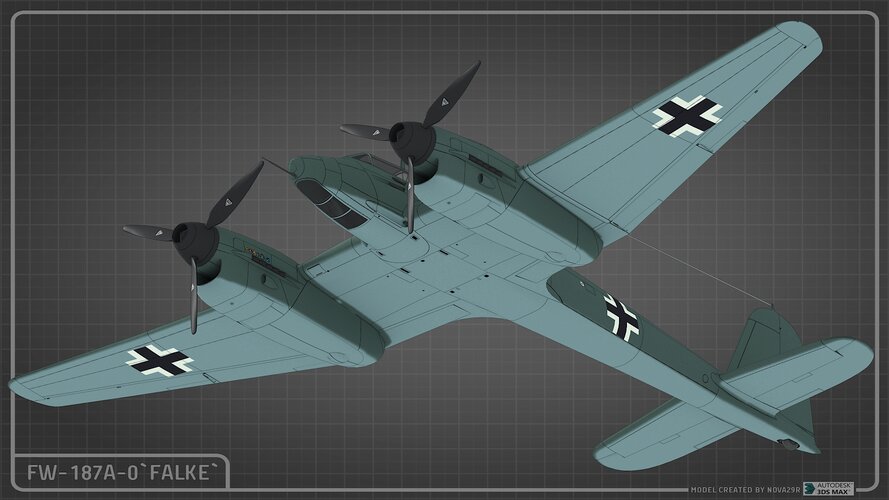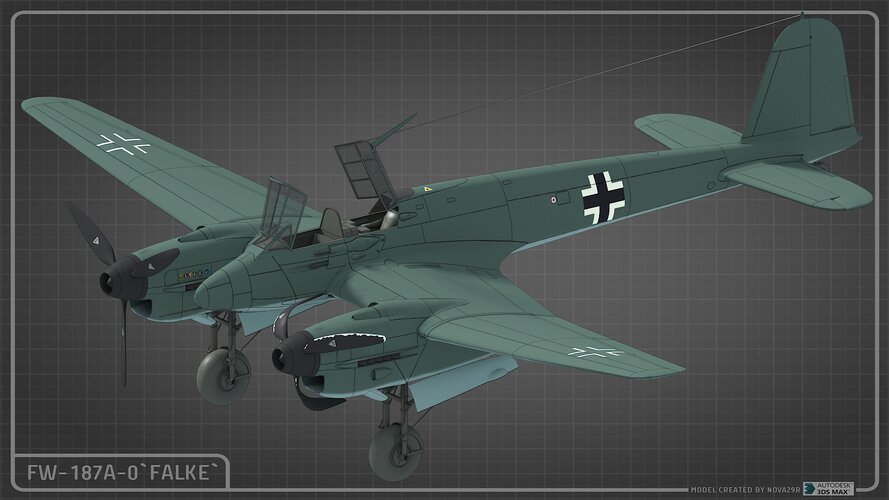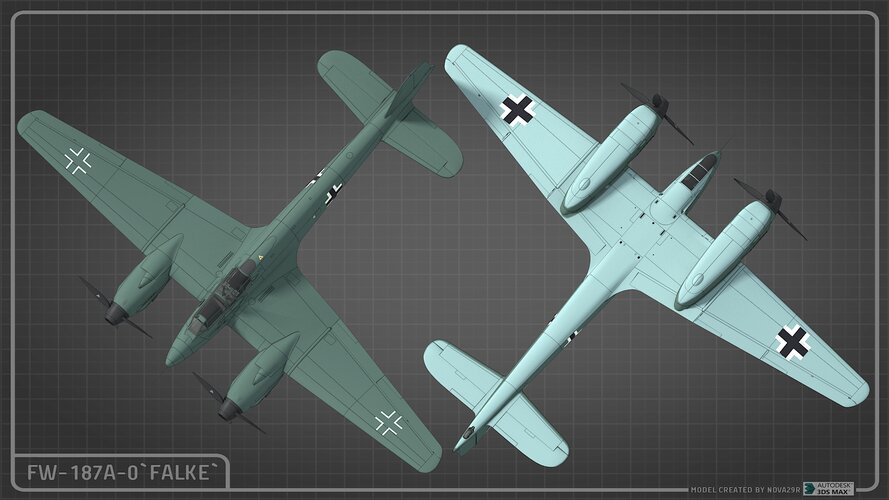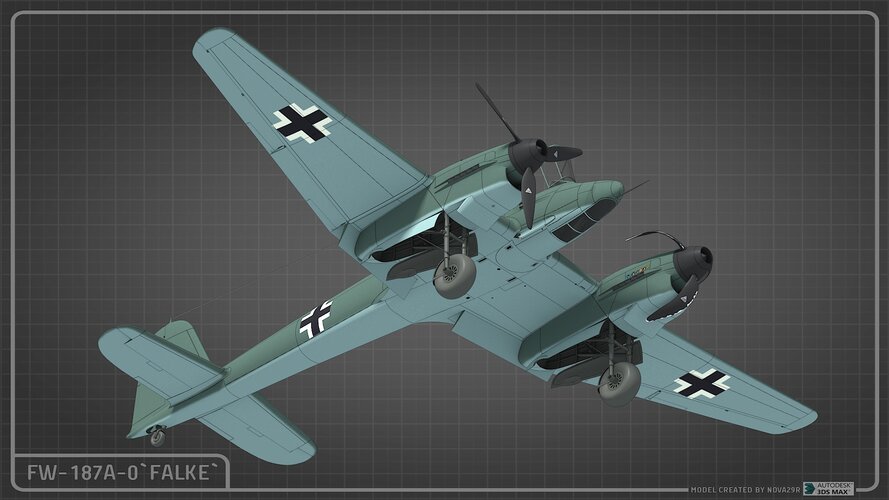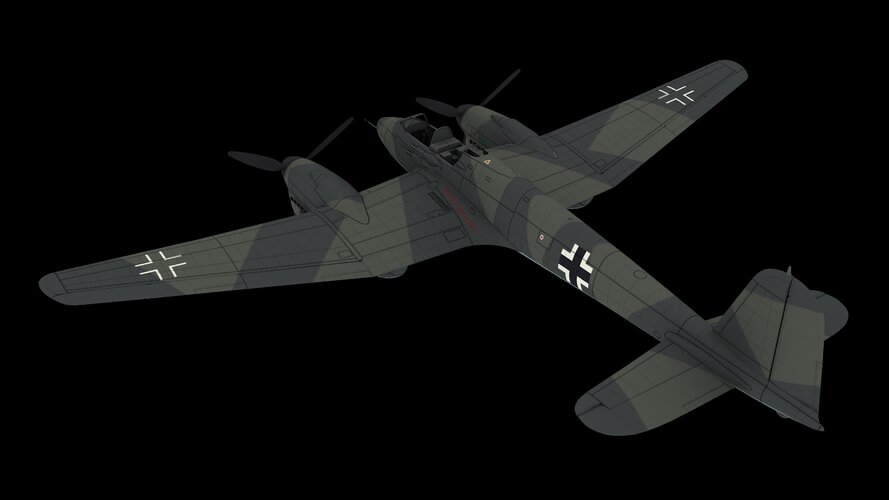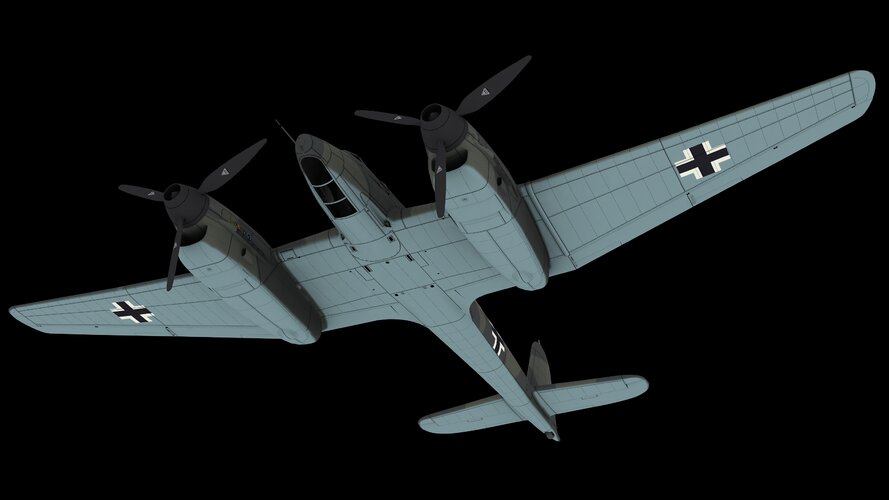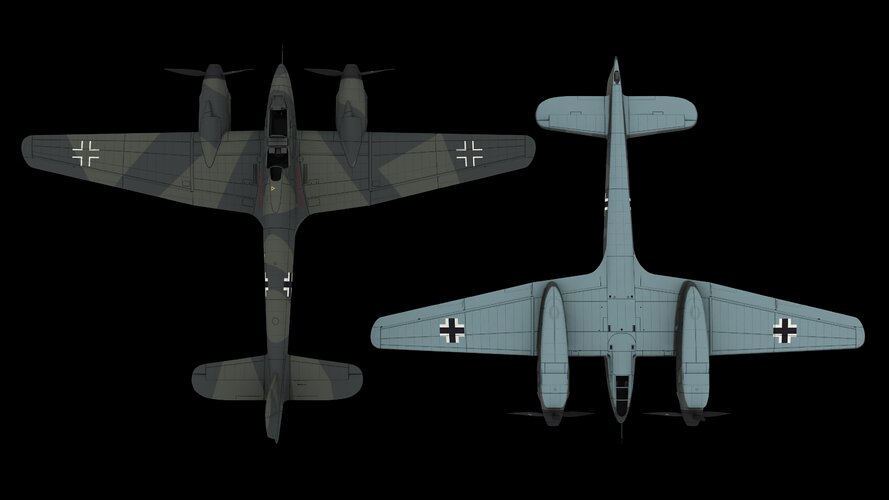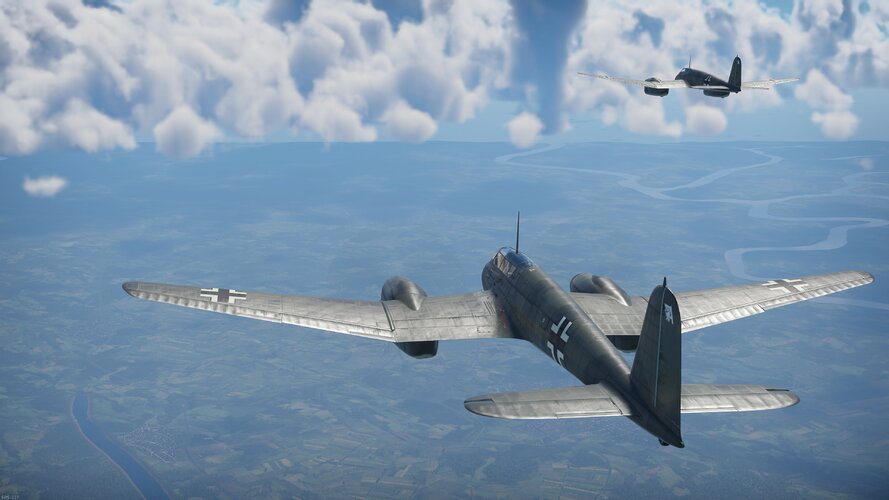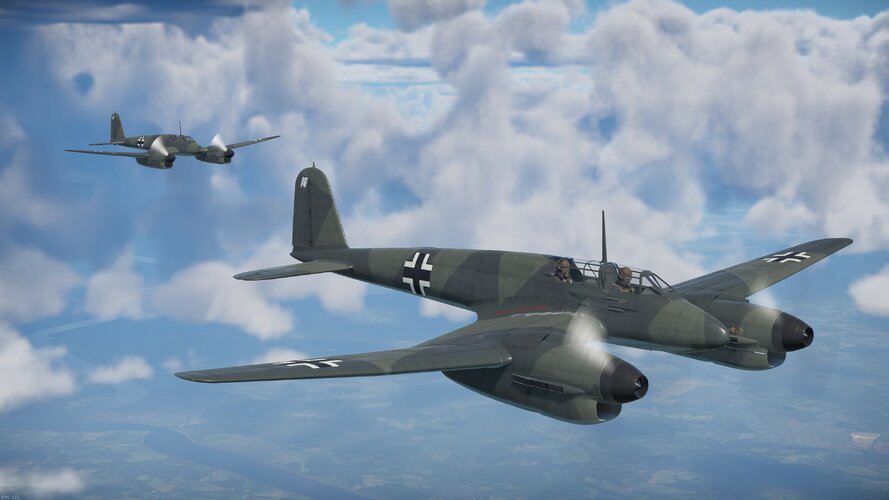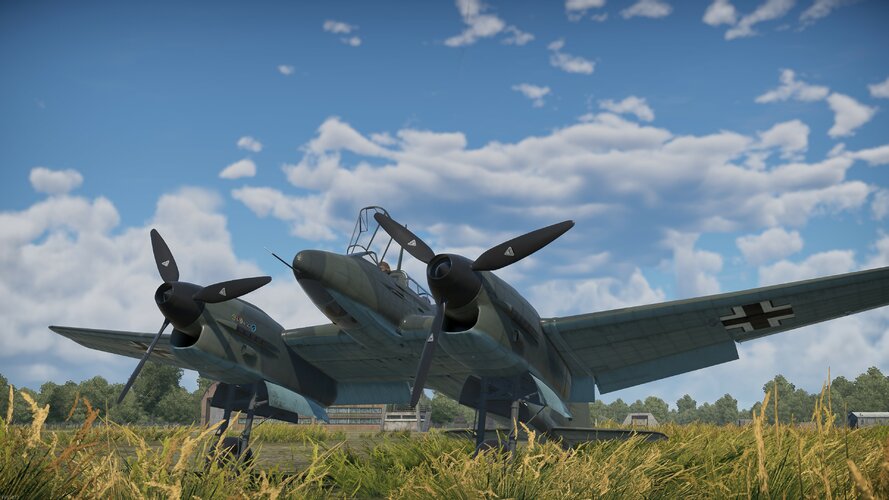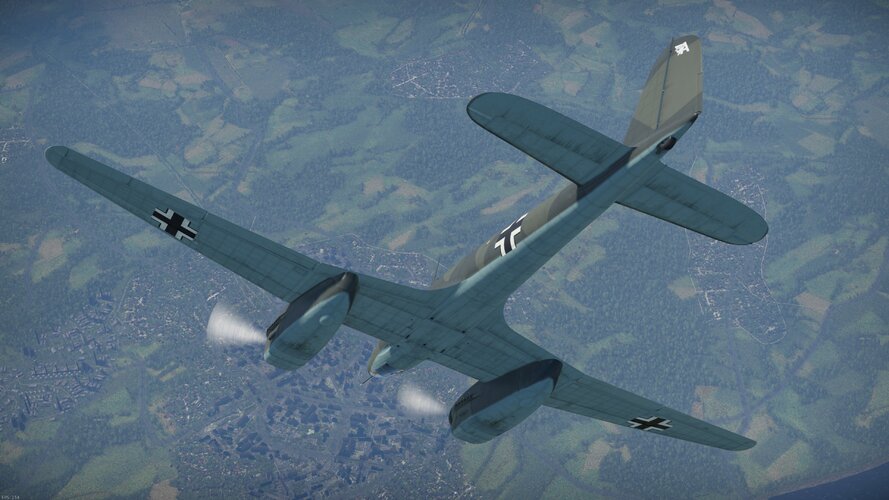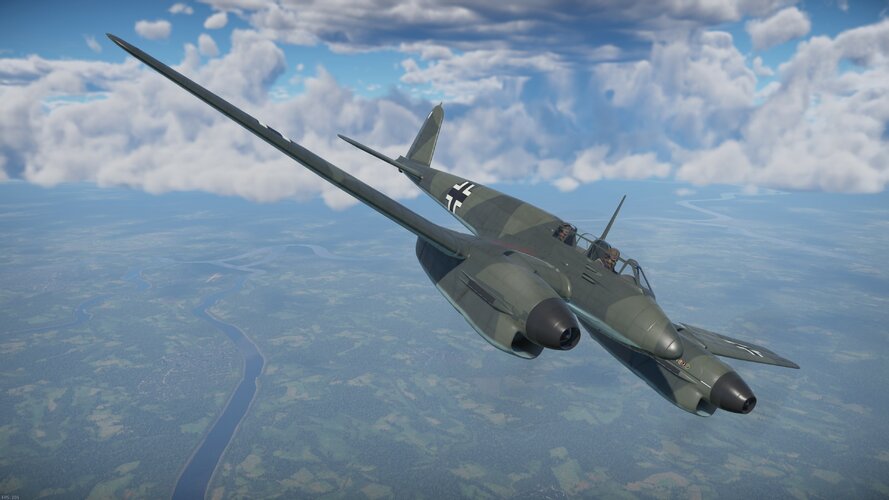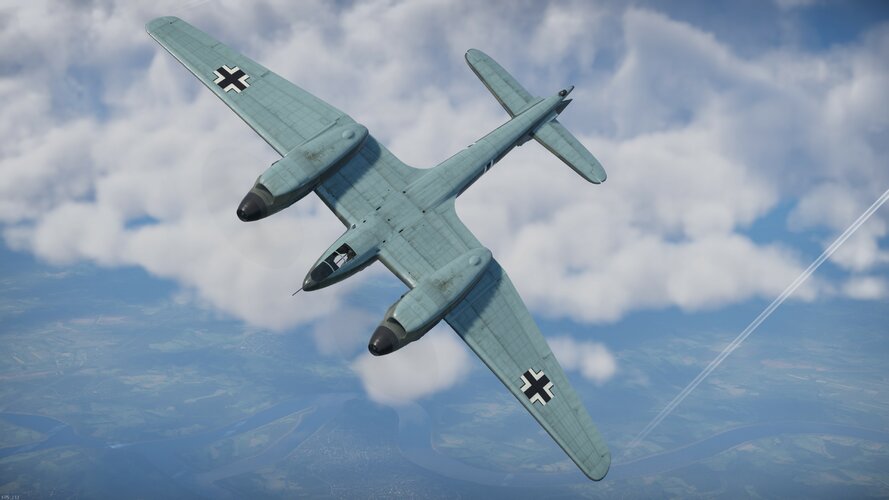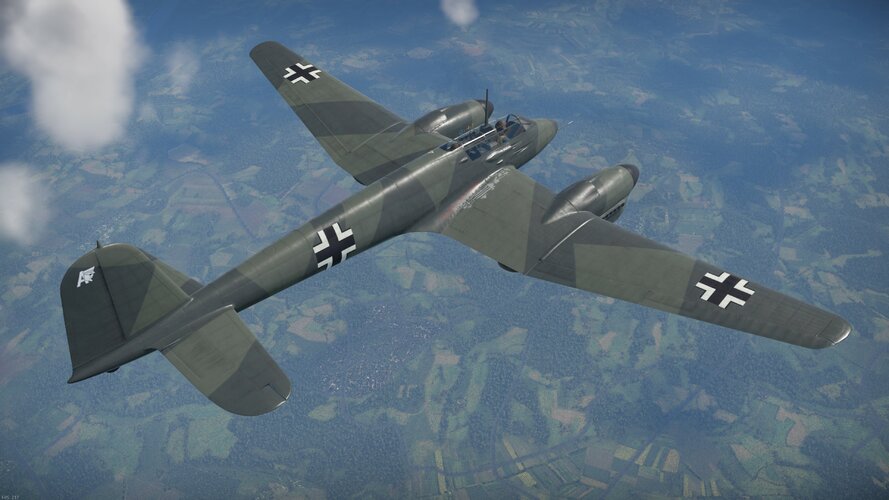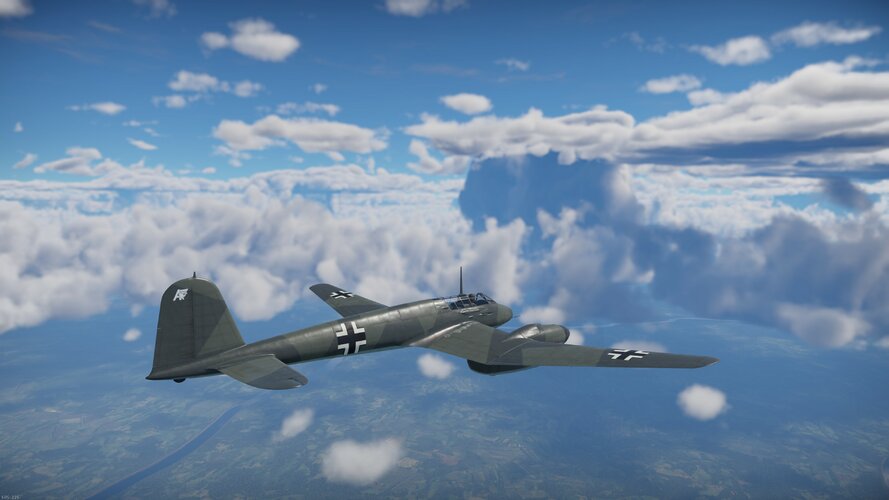If this performance was achieved at sea level, it would be suggestive that the DB 600A was used - this was basically a low altitude engine.I have three books that claim the Fw 187 V6 had DB 600A engines
- Warplanes of the Third Reich by William Green, Doubleday 1970
- German Aircraft of the Second World War by J.R. Smith and Antony Kay, Putnam 1972
- Kurt Tank - Konstrukteur und Testpilot bei Focke-Wulf (Die Deutsche Luftfahrt #1) by Wolfgang Wagner, 2nd edition, Bernard & Graefe 1991 - 1st edition 1980
All authors write the V6 reached a speed of 630 to 635 km/h on trials. Wagner writes that speed was reached 'am Boden' - at ground level (!). Skin buckling, cooling problems are reported by all.
Wagner writes surface evaporative cooling was adopted on the V6 after a suggestion from the RLM. Wagner writes Tank had doubts about the operational use of such cooling.
Green, Smith & Kay all suggest the use of surface evaporative cooling was Tank's own idea.
Side view of V6 from Green, rear view of V6 from Wagner.
Unfortunately, none of the authors provide sources.
You are using an out of date browser. It may not display this or other websites correctly.
You should upgrade or use an alternative browser.
You should upgrade or use an alternative browser.
Focke Wulf Fw-187
- Thread starter Justo Miranda
- Start date
It should be noted that the Hornet used engines that had a much higher rated altitude in addition to having a larger takeoff rating. The later British engines also pressurized the coolant to a greater extent than was employed in the the German engines - this allowed higher coolant temperatures and smaller radiators.The Fw 187A-0's maximum speed, according to Hermann and Petrick's book was 328 mph, the de Havilland Hornet F.3's maximum speed was 472 mph according to Warpaint Series No.19 de Havilland Hornet and Sea Hornet. Tell me how you would expect to get the Fw 187 to equal that speed without carrying out drag reduction measures. Remembering that drag reduction includes improving the profile of the nacelles, radiators etc, which would have to be done if a different engine is put on it at any rate. But would that be enough with the engines that the Germans had at the time?
According to Hermann and Petrick's book, the projected maximum speed of the Fw 187 Kampfzerstorer with 2 DB 605s was 423 mph, which is a big improvement over the previous model, but since this aircraft was not built, they are speculative figures only. They also still trail behind the Hornet by some margin. Even the proposed high altitude single-seat fighter variant with DB 605s, at 450 mph was still not as fast as the production Hornet Mk.3.
Dagger
ACCESS: Secret
- Joined
- 24 December 2019
- Messages
- 334
- Reaction score
- 620
Dagger
ACCESS: Secret
- Joined
- 24 December 2019
- Messages
- 334
- Reaction score
- 620
Dagger
ACCESS: Secret
- Joined
- 24 December 2019
- Messages
- 334
- Reaction score
- 620
Two-part article about cockpit and engine instruments of Fw 187 V2 and V4
by Peter Cohausz in Flugzeug Classic of Nov/Dec 2013.
The two-seater had six instruments in one row above the engine exhausts
The single-seater had two rows above each other of three instruments each, further aft just before the wing leading edge.
by Peter Cohausz in Flugzeug Classic of Nov/Dec 2013.
The two-seater had six instruments in one row above the engine exhausts
The single-seater had two rows above each other of three instruments each, further aft just before the wing leading edge.
Attachments
Could be heavy political influence .Possibly political and/or priorities for production?
Dagger
ACCESS: Secret
- Joined
- 24 December 2019
- Messages
- 334
- Reaction score
- 620
For those of you not yet bored with the Fw 187, a two-part article
by Herbert Ringlstetter in Flugzeug Classic of Jan/Feb 2012:
by Herbert Ringlstetter in Flugzeug Classic of Jan/Feb 2012:
Attachments
Steve Coates
I really should change my personal text
- Joined
- 8 October 2013
- Messages
- 20
- Reaction score
- 52
The BA Berlin-Lichterfelde has digitised a couple of Fw 187 Baubeschreibungen. Freely downloadable via Invenio.
R3/3773 (1942)
R3/3775 (Fw 187 V4)
R3/3773 (1942)
R3/3775 (Fw 187 V4)
- Joined
- 2 January 2011
- Messages
- 345
- Reaction score
- 372
Oh goodie! Another series of articles on a very interesting aircraft that I'll never have a chance to read and understand....Sigh....
Some beautiful artwork and photos overall.
AlanG
Some beautiful artwork and photos overall.
AlanG
The BA Berlin-Lichterfelde has digitised a couple of Fw 187 Baubeschreibungen. Freely downloadable via Invenio.
R3/3773 (1942)
R3/3775 (Fw 187 V4)
Can you walk us through?
Hi Tomo,
When it comes to giving a walk through, that's a rather uncooperative website due to use of session-based Web 2.0 paradigms.
Try to find "invenio", click on "Suche ohne Registrierung", then on "Suche", then enter R3/3773 into the "Signatur" field and click the "Suche" button.
That should give the 1942 result. Click on "Digitalisat" to get the digitized stuff. I think it will only show the actual result if you have registered, which is free and quick, but probably requires some working knowledge of German. As the "Digitalisat" button requires pop-up permission, I am not sure whether I actually had to register or if paying more attention would have sufficed ;-)
From the first hit, you can also click on "something or other im Kontext", which gives a lot more aviation-related stuff.
Regards,
Henning (HoHun)
The BA Berlin-Lichterfelde has digitised a couple of Fw 187 Baubeschreibungen. Freely downloadable via Invenio.
R3/3773 (1942)
R3/3775 (Fw 187 V4)
Can you walk us through?
When it comes to giving a walk through, that's a rather uncooperative website due to use of session-based Web 2.0 paradigms.
Try to find "invenio", click on "Suche ohne Registrierung", then on "Suche", then enter R3/3773 into the "Signatur" field and click the "Suche" button.
That should give the 1942 result. Click on "Digitalisat" to get the digitized stuff. I think it will only show the actual result if you have registered, which is free and quick, but probably requires some working knowledge of German. As the "Digitalisat" button requires pop-up permission, I am not sure whether I actually had to register or if paying more attention would have sufficed ;-)
From the first hit, you can also click on "something or other im Kontext", which gives a lot more aviation-related stuff.
Regards,
Henning (HoHun)
Most excellent, thank you bothWhen it comes to giving a walk through, that's a rather uncooperative website due to use of session-based Web 2.0 paradigms.
Try to find "invenio", click on "Suche ohne Registrierung", then on "Suche", then enter R3/3773 into the "Signatur" field and click the "Suche" button.
That should give the 1942 result. Click on "Digitalisat" to get the digitized stuff. I think it will only show the actual result if you have registered, which is free and quick, but probably requires some working knowledge of German. As the "Digitalisat" button requires pop-up permission, I am not sure whether I actually had to register or if paying more attention would have sufficed ;-)
A veritable gold mineFrom the first hit, you can also click on "something or other im Kontext", which gives a lot more aviation-related stuff.
Hi,
Oops, I didn't see there was no link in the original post ... here's the most direct link on one of the two Fw 187 documents possible:
It's not the world's most linkable site though.
Click to close any splashscreen that might appear, then click on "Digitalisat anzeigen", which will load the document.
It seems you don't need to be registered after all.
Good luck, the site can be a bit awkward to use.
Regards,
Henning (HoHun)
An actual link to the documents would be nice rather than assuming people know what BA Berlin-Lichterfeld
is.
Oops, I didn't see there was no link in the original post ... here's the most direct link on one of the two Fw 187 documents possible:
It's not the world's most linkable site though.
Click to close any splashscreen that might appear, then click on "Digitalisat anzeigen", which will load the document.
It seems you don't need to be registered after all.
Good luck, the site can be a bit awkward to use.
Regards,
Henning (HoHun)
The Fw 187 couldn't even match the performance of its closer rivals of the time; the Gloster F.9/37 fitted with 1,000hp Taurus T-S(a) radials achieved 360mph at 15,000ft, weights were similar; the Grumman XF5F and XP-50 with 1,200hp Cyclones managed 380mph at sea level and had a very impressive 4,000ft/min rate of climb; the Westland Whirlwind was another very similar aircraft and much closer in terms of engine power with the 885hp Peregrine and also managed 360mph at 15,000ft but it did climb slower. The Lockheed P-38 was in an entirely different level of performance.
Sorry for such a late reply on this
Gloster's A/C was without guns and aerials when fitted with Taurus engines, and have had 50% more power at 15000 ft than the Fw 187. When fitted with two guns (real or mock-up; probably does not matter for drag) and Peregrines (885 HP at 15000 ft), it was as fast as the Fw 187 (670 HP at 12140 ft).
Whirlwind has the same advantage in power, and it is/was smaller A/C than the Fw 187, so extra speed is to be expected.
(Gloster F.9/37 really warranted Merlin power from day one, in order to be competitive for the ww2)
Grumman XF5F was good for 312 mph at SL, not 380. See SAC.
XP-50 suffered explosion of one of it's turboes during the 1st flight, meaning that it's 380 mph figure, especially at SL, is as true as the 390-400 mph figure for the XP-39 - ie. not worth hanging one's hat on it.
P-38 is a good reality-check for the XP-50, the later having far draggier engines in front of the wings. With 2x1150 HP, the unarmed YP-38 did 345 mph TAS, and the service-worthy P-38D was more than 20 mph slower there. Later P-38s, with more power, were still hard pressed to beat 350 mph mark.
Hi Tomo,
Gloster F.9/37 data is a bit odd, as I realized when I tried to analyze its performance recently: https://www.secretprojects.co.uk/threads/gloster-f9-37.9847/#post-563984
I think the data for the Peregrine-engined variant is probably more useful, as we have a fair understanding of the Peregrine performance (though there frequently is some ambiguity when it comes to which power settings were actually used to achieve any particular top speed), while the Taurus normally has a fairly low full-throttle height not compatible with the full-throttle height speeds reported for the Taurus-engined variants. Of course, it might have used a Taurus variant with a different supercharger setup, but as driving a supercharger costs power (and heats the induction air), that would reduce the power available at altitude.
Regards,
Henning (HoHun)
Gloster's A/C was without guns and aerials when fitted with Taurus engines, and have had 50% more power at 15000 ft than the Fw 187.
Gloster F.9/37 data is a bit odd, as I realized when I tried to analyze its performance recently: https://www.secretprojects.co.uk/threads/gloster-f9-37.9847/#post-563984
I think the data for the Peregrine-engined variant is probably more useful, as we have a fair understanding of the Peregrine performance (though there frequently is some ambiguity when it comes to which power settings were actually used to achieve any particular top speed), while the Taurus normally has a fairly low full-throttle height not compatible with the full-throttle height speeds reported for the Taurus-engined variants. Of course, it might have used a Taurus variant with a different supercharger setup, but as driving a supercharger costs power (and heats the induction air), that would reduce the power available at altitude.
Regards,
Henning (HoHun)
My understanding is that the engine version used to propel the F.9/37 were turning 3300 rpm - that, coupled with 'normal' altitude S/C gearing that indeed might provide the 1000HP at high altitude (14k-15k ft? without ram effect). Taurus engines that entered service were doing 3100 rpm, and were still troublesome when doing that.I think the data for the Peregrine-engined variant is probably more useful, as we have a fair understanding of the Peregrine performance (though there frequently is some ambiguity when it comes to which power settings were actually used to achieve any particular top speed), while the Taurus normally has a fairly low full-throttle height not compatible with the full-throttle height speeds reported for the Taurus-engined variants. Of course, it might have used a Taurus variant with a different supercharger setup, but as driving a supercharger costs power (and heats the induction air), that would reduce the power available at altitude.
Goes without saying that I'd just love to see flight tests of many, many pre-war British and German aircraft, so we can confirm or rebute the often-quoted max speed figures, as well as to see where the manufacturer was believed in good faith. Eg. F-W was expecting 545 km/f for the Fw 187A; however, reality was different.
Hi Tomo,
I'd suggest to discuss the Gloster over in the Gloster thread, but the Taurus II is listed here ... https://en.wikipedia.org/wiki/Bristol_Taurus ... with a full-throttle height of 5000 ft at 3220 rpm. Wikipedia is not the greatest of sources, but at least in this case they state that they pulled all that data from a single, specified book. Based on the data Going from 3220 rpm to 3300 rpm is not going to make much of a difference with regard to full throttle height.
Hm, is there any indication it didn't achieve the projected speeds? The test pilot Sander mentioned achieving 525 km/h at low altitude, which not so far from 545 km/h ...
Regards,
Henning (HoHun)
My understanding is that the engine version used to propel the F.9/37 were turning 3300 rpm - that, coupled with 'normal' altitude S/C gearing that indeed might provide the 1000HP at high altitude (14k-15k ft? without ram effect). Taurus engines that entered service were doing 3100 rpm, and were still troublesome when doing that.
I'd suggest to discuss the Gloster over in the Gloster thread, but the Taurus II is listed here ... https://en.wikipedia.org/wiki/Bristol_Taurus ... with a full-throttle height of 5000 ft at 3220 rpm. Wikipedia is not the greatest of sources, but at least in this case they state that they pulled all that data from a single, specified book. Based on the data Going from 3220 rpm to 3300 rpm is not going to make much of a difference with regard to full throttle height.
Eg. F-W was expecting 545 km/f for the Fw 187A; however, reality was different.
Hm, is there any indication it didn't achieve the projected speeds? The test pilot Sander mentioned achieving 525 km/h at low altitude, which not so far from 545 km/h ...
Regards,
Henning (HoHun)
Hm, is there any indication it didn't achieve the projected speeds? The test pilot Sander mentioned achieving 525 km/h at low altitude, which not so far from 545 km/h ...
My point was to show that often-touted speed figures require a grain of salt most of the times.
i wonder if they have something about bf209v5 there....
Hi Tomo,
In the case of the Fw 187, there are no reports of the aircraft being slow, no criticism of the engines (which often happens if an aircraft is on the slow side), no downward revision of the figures in subsequent variants (the V4 and the DB 605/BMW 801), and no re-design of either engine-related aspects or primarily speed-related aspects of the aircraft, so overall, my working hypothesis would be that the Fw 187 probably more or less hit the projected numbers.
I'm pretty sure the Fw 187 was doomed from the start because it was stuck half-way between the more economical Me 109 and the more multi-role Me 110. Its only selling point was superior performance, and my gut feeling is that if the Fw 187 had been a disappointment in that respect, that would not have gone unnoticed in the competive environment of Luftwaffe procurement (to use a friendly term ;-).
Regards,
Henning (HoHun)
Hm, is there any indication it didn't achieve the projected speeds? The test pilot Sander mentioned achieving 525 km/h at low altitude, which not so far from 545 km/h ...
My point was to show that often-touted speed figures require a grain of salt most of the times.
In the case of the Fw 187, there are no reports of the aircraft being slow, no criticism of the engines (which often happens if an aircraft is on the slow side), no downward revision of the figures in subsequent variants (the V4 and the DB 605/BMW 801), and no re-design of either engine-related aspects or primarily speed-related aspects of the aircraft, so overall, my working hypothesis would be that the Fw 187 probably more or less hit the projected numbers.
I'm pretty sure the Fw 187 was doomed from the start because it was stuck half-way between the more economical Me 109 and the more multi-role Me 110. Its only selling point was superior performance, and my gut feeling is that if the Fw 187 had been a disappointment in that respect, that would not have gone unnoticed in the competive environment of Luftwaffe procurement (to use a friendly term ;-).
Regards,
Henning (HoHun)
I'd suggest to discuss the Gloster over in the Gloster thread, but the Taurus II is listed here ... https://en.wikipedia.org/wiki/Bristol_Taurus ... with a full-throttle height of 5000 ft at 3220 rpm. Wikipedia is not the greatest of sources, but at least in this case they state that they pulled all that data from a single, specified book. Based on the data Going from 3220 rpm to 3300 rpm is not going to make much of a difference with regard to full throttle height.
I've looked at what Lumsden has to say. He lists 3100 rpm max for the Taurus, bar for the (very elusive) Mk.III that was 'fully supercharged' and was supposed to do 3300 rpm.
I'd suggest to discuss the Gloster over in the Gloster thread, but the Taurus II is listed here ... https://en.wikipedia.org/wiki/Bristol_Taurus ... with a full-throttle height of 5000 ft at 3220 rpm.
The manual for the Albacore was posted on another forum today
Confirms 3100 rpm for Taurus II and XII.
Hi Tomo,
Oh, I didn't realize there were two different books. I have the German edition, which is indeed by Hermann and Petrick. However, googling it, there seems to be an English edition of a book by Hermann and Petrick as well (Schiffer, "Focke-Wulf Fw 187: An Illustrated History"), which has the same page count as my German book. I would suspect that the Schiffer book is a translation, but I don't actually know!
Regards,
Henning (HoHun)
@HoHun - am I better off with English-language book about the Fw 187 (by Hermann), or the German-language one (by Petrick and Hermann)?
Oh, I didn't realize there were two different books. I have the German edition, which is indeed by Hermann and Petrick. However, googling it, there seems to be an English edition of a book by Hermann and Petrick as well (Schiffer, "Focke-Wulf Fw 187: An Illustrated History"), which has the same page count as my German book. I would suspect that the Schiffer book is a translation, but I don't actually know!
Regards,
Henning (HoHun)
Oh, I didn't realize there were two different books. I have the German edition, which is indeed by Hermann and Petrick. However, googling it, there seems to be an English edition of a book by Hermann and Petrick as well (Schiffer, "Focke-Wulf Fw 187: An Illustrated History"), which has the same page count as my German book. I would suspect that the Schiffer book is a translation, but I don't actually know!
My bad - Amazon lists only Hermann as an author of the English-language version, however Petrick is also stated as authour on the title page.
However, if you have an insight on what book might be better - sometimes something gets lost in translation - I'd love to hear it.
Hi Tomo,
As I haven't read the English book, I can't really comment. Usually I prefer the original language edition, if I understand it well enough - unless there's a price or availability barrier.
Regards,
Henning (HoHun)
My bad - Amazon lists only Hermann as an author of the English-language version, however Petrick is also stated as authour on the title page.
However, if you have an insight on what book might be better - sometimes something gets lost in translation - I'd love to hear it.
As I haven't read the English book, I can't really comment. Usually I prefer the original language edition, if I understand it well enough - unless there's a price or availability barrier.
Regards,
Henning (HoHun)
As I haven't read the English book, I can't really comment. Usually I prefer the original language edition, if I understand it well enough - unless there's a price or availability barrier.
Thank you.
I've just ordered the German-language version.
@HoHun - the book has arrived, and I've quick-read it once. A small detail - only once the turn of speed of 525 km/h is noted (and on the sea level, go figure), and that is from Sander's interview. Unfortunately, per both Wikipedias (EN + DE), that is the speed figure quoted, and at 4000-4200m.
Question: should we consider the 525 km/h at 4000-4200 as a worthwhile data point?
Question: should we consider the 525 km/h at 4000-4200 as a worthwhile data point?
Hi Tomo,
I wouldn't necessarily read "in Bodennähe" (on p. 17) as "at sea level", but I had only brought up this point to show that there was no disappointment about the speed of the aircraft.
Fortunately (because altitude isn't documented, and we don't even know if that was measured with calibrated instruments and reduced to standard day conditions), we don't need to consider this as a data point since Fw 187 V-2 was tested for performance in Rechlin, yielding 501 km/h at 3 km (and probably very slightly more a couple of 100 meters lower, as at 3 km, boost pressure had already dropped off a tiny bit).
525 km/h @ 4 km makes no sense for the V-1 since that was a kilometer above the full throttle height of the Jumo 210D that was installed in that aircraft. However, it's quoted there for the Fw 187A-0, which had the Jumo 210G according to the Baubeschreibung, but the Baubeschreibung provides a speed of 545 km/h @ 4.6 km.
The Wikipedia quotes "Die deutsche Luftrüstung", which is authored by Nowarra - so the automatic reflex is "disregard" since Norwarra is infamous for his many careless inaccuracies.
One thing to keep in mind is that the V-2 test was flown at the 5 minute power setting, while normal German procedure was to use the 30 minute power setting. If Nowarra was quoting the 30 min settings, that might be another explanation for the difference (though I'd like to know where he was quoting it from).
Another thing to keep in mind is that the top speed was not actually achieved at 4 km, but at 4.6 km, so Nowarra might be reporting on a realistic data point that simply is not a characteristic data point of the speed graph. 525 km/h might be in the ball park in that case, though from the Baubeschreibung, I'd have expected around 535 km/h.
Without the context of Nowarra's numbers, it's hard to tell for certain.
Here's another graph showing my calculation for the V-2, hypothetically equipped with the Jumo 210G of the V-4 and brought up to the V-4's 5000 kg weight, for comparison with the speeds from the Baubeschreibung ... I've added the 30 min power setting that's normally indicated on the German characteristic sheets as a solid line.

Regards,
Henning (HoHun)
@HoHun - the book has arrived, and I've quick-read it once. A small detail - only once the turn of speed of 525 km/h is noted (and on the sea level, go figure), and that is from Sander's interview. Unfortunately, per both Wikipedias (EN + DE), that is the speed figure quoted, and at 4000-4200m.
Question: should we consider the 525 km/h at 4000-4200 as a worthwhile data point?
I wouldn't necessarily read "in Bodennähe" (on p. 17) as "at sea level", but I had only brought up this point to show that there was no disappointment about the speed of the aircraft.
Fortunately (because altitude isn't documented, and we don't even know if that was measured with calibrated instruments and reduced to standard day conditions), we don't need to consider this as a data point since Fw 187 V-2 was tested for performance in Rechlin, yielding 501 km/h at 3 km (and probably very slightly more a couple of 100 meters lower, as at 3 km, boost pressure had already dropped off a tiny bit).
525 km/h @ 4 km makes no sense for the V-1 since that was a kilometer above the full throttle height of the Jumo 210D that was installed in that aircraft. However, it's quoted there for the Fw 187A-0, which had the Jumo 210G according to the Baubeschreibung, but the Baubeschreibung provides a speed of 545 km/h @ 4.6 km.
The Wikipedia quotes "Die deutsche Luftrüstung", which is authored by Nowarra - so the automatic reflex is "disregard" since Norwarra is infamous for his many careless inaccuracies.
One thing to keep in mind is that the V-2 test was flown at the 5 minute power setting, while normal German procedure was to use the 30 minute power setting. If Nowarra was quoting the 30 min settings, that might be another explanation for the difference (though I'd like to know where he was quoting it from).
Another thing to keep in mind is that the top speed was not actually achieved at 4 km, but at 4.6 km, so Nowarra might be reporting on a realistic data point that simply is not a characteristic data point of the speed graph. 525 km/h might be in the ball park in that case, though from the Baubeschreibung, I'd have expected around 535 km/h.
Without the context of Nowarra's numbers, it's hard to tell for certain.
Here's another graph showing my calculation for the V-2, hypothetically equipped with the Jumo 210G of the V-4 and brought up to the V-4's 5000 kg weight, for comparison with the speeds from the Baubeschreibung ... I've added the 30 min power setting that's normally indicated on the German characteristic sheets as a solid line.
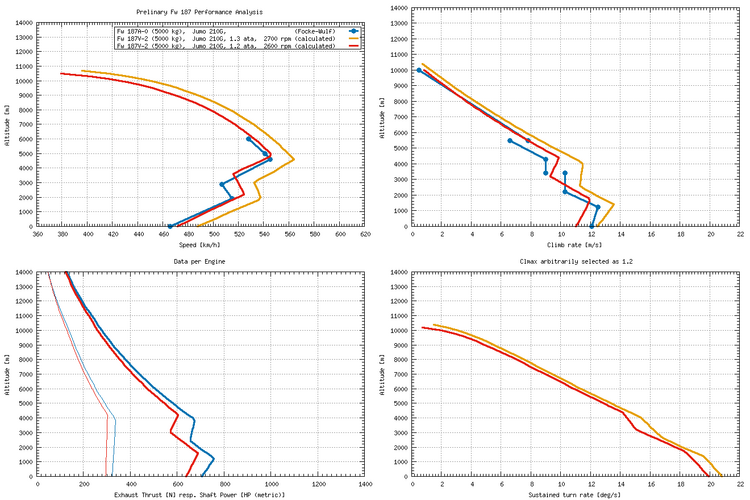
Regards,
Henning (HoHun)
Hi Nova,
Outstanding, thanks a lot for sharing!
There's a German cockpit description in https://www.secretprojects.co.uk/threads/focke-wulf-fw-187.9760/page-4#post-466525 with some (sort of low resolution) cockpit photographs. If you need help with the German, just ask!
I noticed that the threeview drawings posted in this thread don't seem to be terribly accurate ... as your model looks very true to the original photographs, did you find any good source for accurate drawings?
Regards,
Henning (HoHun)
Drop some pictures of a 3d model i make.
maybe some one can help with some good cockpit photos? or scans from book.
Outstanding, thanks a lot for sharing!
There's a German cockpit description in https://www.secretprojects.co.uk/threads/focke-wulf-fw-187.9760/page-4#post-466525 with some (sort of low resolution) cockpit photographs. If you need help with the German, just ask!
I noticed that the threeview drawings posted in this thread don't seem to be terribly accurate ... as your model looks very true to the original photographs, did you find any good source for accurate drawings?
Regards,
Henning (HoHun)
Hello!
It seems controversial, even in this thread, whether it was Fw 187 V-5 or V-6 that was powered by DB 601 and had evaporative cooling system.
In Bundesarchive's collection is "Flugzeug FW 187 A-O, V-4, V-5.- Auftragsabrechnungen": https://invenio.bundesarchiv.de/invenio/direktlink/79e59f20-f32a-430b-8775-b7bd9febf65b/ .
A set of cost calculations regarding Fw 187 V-5 Werknummer 1976 begins with picture 46.
It is clear that V-5 was powered by DB 601 Vs (p. 49).
Item "Kondenspumpe", quantity of 2, supplied by "D B" (p. 58) seems to be related with evaporative cooling.
Then again the document also lists "Wasserkuehler", four of them, worth 520 RM each (p. 59), while V-4 had two, 680 RM each (p. 80).
Baugruppe numbers indicate that V-5 had the same fuselage as V-4, but different wings and landing gear. Which is rather obvious, considering weight difference between Jumo 210s and DB 601s.
Similar calculations regarding Fw 187 A-0s make it clear that those planes armament, apart from two MG 17, was - or was to be - two MG 151 (p. 21 and p. 109). Not two MG FF, as they usually say.
Fw 187 V-4 Baubeschreibung says that the plane could be armed with any of those heavier weapons.
It seems controversial, even in this thread, whether it was Fw 187 V-5 or V-6 that was powered by DB 601 and had evaporative cooling system.
In Bundesarchive's collection is "Flugzeug FW 187 A-O, V-4, V-5.- Auftragsabrechnungen": https://invenio.bundesarchiv.de/invenio/direktlink/79e59f20-f32a-430b-8775-b7bd9febf65b/ .
A set of cost calculations regarding Fw 187 V-5 Werknummer 1976 begins with picture 46.
It is clear that V-5 was powered by DB 601 Vs (p. 49).
Item "Kondenspumpe", quantity of 2, supplied by "D B" (p. 58) seems to be related with evaporative cooling.
Then again the document also lists "Wasserkuehler", four of them, worth 520 RM each (p. 59), while V-4 had two, 680 RM each (p. 80).
Baugruppe numbers indicate that V-5 had the same fuselage as V-4, but different wings and landing gear. Which is rather obvious, considering weight difference between Jumo 210s and DB 601s.
Similar calculations regarding Fw 187 A-0s make it clear that those planes armament, apart from two MG 17, was - or was to be - two MG 151 (p. 21 and p. 109). Not two MG FF, as they usually say.
Fw 187 V-4 Baubeschreibung says that the plane could be armed with any of those heavier weapons.

